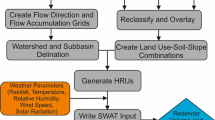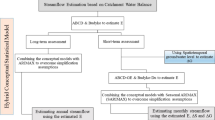Abstract
Determining the link between rainfall and flow for a watershed is one of the most imperative problems and challenging tasks faced by hydrologists and engineers. Conceptual and Box-Jenkins hydrological models represent suitable tools for this purpose in circumstance of data Scarce and climate complexity. This research consists in a comparative study between conceptual models and Box-Jenkins model, namely, GR2M, ABCD, and the autoregressive moving average (ARIMA) which has a numerical design. The three models were applied to three catchments located in the north-west of Algeria. Basins have been selected according to the availability of long-time series of hydrological and climatic data (more than 30 years) to calibrate parsimonious models, taking into account the climatic variables and the stochastic behavior of the natural stream flow. Overall, the conceptual models perform similarly; whereas the results show that the GR2M model performed better than the ABCD in the validation stage, the stochastic model shows better results as opposed to conceptual models in the case of the Mellah Wadi which presents high permeability in its behavior. This is due to the simplicity of the model needed for data (only runoff data) and the ability of the stochastic model to produce stream flow in complex catchments. Such circumstance could be caused by different motivations. On the one hand, the diverse number of model parameters that make the ABCD the less parsimonious approach, with four parameters to be calibrated. On the other hand, the inability of the ABCD and the ARIMA model to capture and describe the groundwater processes, important for the cases study. Moreover, the validation period includes a large drought period, started in the late 1980s, which makes difficult model adaptation to different hydrological regimes.













Similar content being viewed by others
References
Abudu S, C-l C, King JP, Abudukadeer K (2010) Comparison of performance of statistical models in forecasting monthly streamflow of Kizil River, China. Water Sci Eng 3:269–281
Ahn K-H, Merwade V (2014) Quantifying the relative impact of climate and human activities on streamflow. J Hydrol 515:257–266
Ahsan M, O’Connor KM (1994) A reappraisal of the Kalman filtering technique as applied in river flow forecasting. J Hydrol Eng 161:197–226
Al-Juboori AM, Guven A (2016) A stepwise model to predict monthly streamflow. J Hydrol 543:283–292
Alley WM (1984) On the treatment of evapotranspiration, soil moisture accounting, and aquifer recharge in monthly water balance models. Water Resour Res 20:1137–1149
Bai P, Liu X, Liang K, Liu C (2015) Comparison of performance of twelve monthly water balance models in different climatic catchments of China. J Hydrol 529:1030–1040
Bakreti A, Braud I, Leblois E, Benali A (2013) Analyse conjointe des régimes pluviométriques et hydrologiques dans le bassin de la Tafna (Algérie Occidentale). Hydrol Sci J 58:133–151
Beaumont P, Blake G, Wagstaff JM (2016) The Middle East: a geographical study vol 13. Routledge
Belarbi H, Touaibia B, Boumechra N, Amiar S, Baghli N (2017) Sécheresse et modification de la relation pluie–débit: cas du bassin versant de l’Oued Sebdou (Algérie Occidentale). Hydrol Sci J 62:124–136
Benest M (1985) Evolution de la plate forme de l’Ouest algérien et du Nord-Est Marocain au cours du Jurassique supérieur et au Crétacé: Stratigraphie, milieux de dépôts et dynamique sédimentaire Doc Lab Géol, Univ, Lyon1 Fasc I et II
bin Shaari MA, Samsudin R, bin Shabri Ilman A (2017) Comparison of drought forecasting using ARIMA and empirical wavelet Transform-ARIMA. In: International Conference of Reliable Information and Communication Technology. Springer, pp 449-458
Boudjadja A, Messahel M, Pauc H (2003) Assessment of water resources in Northern Algeria. Revue des Sciences de l’Eau/J Water Sci 16:285–304
Castellano-Méndez MA, González-Manteiga W, Febrero-Bande M, Prada-Sánchez JM, Lozano-Calderón R (2004) Modelling of the monthly and daily behaviour of the runoff of the Xallas river using Box–Jenkins and neural networks methods. J Hydrol 296:38–58
Farajzadeh J, Fard AF, Lotfi S (2014) Modeling of monthly rainfall and runoff of Urmia lake basin using “feed-forward neural network” and “time series analysis” model. Water Resour Ind 7:38–48
Ghanbarpour MR, Abbaspour KC, Jalalvand G, Moghaddam GA (2010) Stochastic modeling of surface stream flow at different time scales: Sangsoorakh karst basin, Iran. J Cave Karst Stud 72:1–10
Graupe D, Isailovic D, Yevjevich V (1976) Prediction model for runoff from karstified catchments. In: United States-Yugoslavian Symposium on Karst Hydrology and Water Resources. Dubrovnik (Yugoslavia). 2-7 Jun 1975
Hamilton JD (1994) Time series analysis vol 2. Princeton university press, Princeton
Kabouya M (1990) Modélisation pluie-débit aux pas de temps mensuel et annuel en Algérie septentrionale
Karamouz M, Araghinejad S (2012) Advance hydrology. Amirkabir University of Technology Press
Liu X, Dai X, Zhong Y, Li J, Wang P (2013) Analysis of changes in the relationship between precipitation and streamflow in the Yiluo River, China. Theor Appl Climatol 114:183–191
Lyon SW, King K, Polpanich O-U, Lacombe G (2017) Assessing hydrologic changes across the Lower Mekong Basin. J Hydrol Reg Stud 12:303–314
Machekposhti KH, Sedghi H, Telvari A, Babazadeh H (2018) Modeling climate variables of rivers basin using time series analysis (case study: Karkheh River Basin at Iran). Civ Eng J 4:78–92
Makhlouf Z (1994) Compléments sur le modèle pluie-débit GR 4 J et essai d’estimation de ses paramètres
McCuen RH (2016) Modeling hydrologic change: statistical methods. CRC press
Meddi M, Hubert P (2003) Impact de la modification du régime pluviométrique sur les ressources en eau du Nord-Ouest de l’Algérie IAHS publication: 229-235
Merabet-Baghli N, Bouanani A, Billaud J (2018) Comment traiter la question de l’eau en Algérie. Techn Sci Méthodes:33–46
Mishra A, Desai V (2005) Drought forecasting using stochastic models. Stoch Env Res Risk A 19:326–339
Mohammadi K, Eslami H, Dayani DS (2005) Comparison of regression, ARIMA and ANN models for reservoir inflow forecasting using snowmelt equivalent (a case study of Karaj)
Moriasi DN, Arnold JG, Van Liew MW, Bingner RL, Harmel RD, Veith TL (2007) Model evaluation guidelines for systematic quantification of accuracy in watershed simulations. Trans ASABE 50:885–900
Mouelhi S (2003) Vers une chaîne cohérente de modèles pluie-débit conceptuels globaux aux pas de temps pluriannuel, annuel, mensuel et journalier. ENGREF, Paris
Mouelhi S, Michel C, Perrin C, Andréassian V (2006) Stepwise development of a two-parameter monthly water balance model. J Hydrol 318:200–214
Nash JE, Sutcliffe JV (1970) River flow forecasting through conceptual models part I—A discussion of principles. J Hydrol 10:282–290
Otmane A, Baba-Hamed K, Bouanani A, Safa A (2017) Prédétermination des valeurs de crues extrêmes et contribution de la plaine de Sidi Bel-Abbès dans le bilan hydrologique du bassin versant de l’oued. Mekerra Techniques Sciences Méthodes: 27-48
Pallard B, Castellarin A, Montanari A (2009) A look at the links between drainage density and flood statistics. Hydrol Earth Syst Sci 13:1019–1029
Parajka J, Blöschl G, Merz R (2007) Regional calibration of catchment models: potential for ungauged catchments. Water Resour Res 43. https://doi.org/10.1029/2006WR005271
Paturel JE et al (2017) Using land cover changes and demographic data to improve hydrological modeling in the Sahel. Hydrol Process 31:811–824
Refsgaard JC, Knudsen J (1996) Operational validation and intercomparison of different types of hydrological models. Water Resour Res 32:2189–2202
Series GBGJT (1976) Analysis: forecasting and control, revised edn. Holden Day, San Francisco
Sharifi M (2018) Calibration and verfication of a-two parameter monthly water balance model and its application potential for evaluation of water resources-a case study of Kalu and Mahaweli rivers of Sri Lanka
Singh J, Knapp HV, Arnold J, Demissie M (2005) Hydrological modeling of the Iroquois River watershed using HSPF and SWAT JAWRA. J Am Water Resour Assoc 41:343–360
Souza JO, Correa AC, Brierley GJ (2016) An approach to assess the impact of landscape connectivity and effective catchment area upon bedload sediment flux in Saco Creek Watershed, Semiarid Brazil. Catena 138:13–29
Taïbi S, et al. (2017) Etat de la variabilité pluviométrique du nord de l'Algérie entre 1936 et 2016: un retour vers la normale. 7ème conférence Eauclimat-santé
Thomas HA (1981) Improved Methods for National Water Assessment. Report, Contract: WR15249270. Washington, D.C.: US Water Resource Council
Traore VB, Sambou S, Tamba S, Diaw A, Cisse M, Fall S (2014) Calibrating the rainfall-runoff model GR4J and GR2M on the Koulountou river basin, a tributary of the Gambia river. Am J Environ Prot 3:36–44
Valipour M (2015) Long-term runoff study using SARIMA and ARIMA models in the United States. Meteorol Appl 22:592–598
Valipour M, Banihabib ME, Behbahani SMR (2013) Comparison of the ARMA, ARIMA, and the autoregressive artificial neural network models in forecasting the monthly inflow of Dez dam reservoir. J Hydrol 476:433–441
Wagener T, Wheater H, Gupta HV (2004) Rainfall-runoff modelling in gauged and ungauged catchments. World Scientific
Wang Q, Pagano T, Zhou S, Hapuarachchi H, Zhang L, Robertson D (2011) Monthly versus daily water balance models in simulating monthly runoff. J Hydrol 404:166–175
Wheater H (2002) Progress in and prospects for fluvial flood modelling. Philos Trans R Soc Lond A Math Phys Eng Sci 360:1409–1431
Wold H (1938) A study in the analysis of stationary time series. Almqvist & Wiksell
Xu C-Y (2002) Hydrologic models textbooks of Uppsala University. Department of Earth Sciences Hydrology
Yule GU (1926) Why do we sometimes get nonsense-correlations between Time-Series? A study in sampling and the nature of time-series. J R Stat Soc 89:1–63
Acknowledgments
The authors wish to thank the National Agency of Water Resources (ANRH) for providing material help and data on which reported analyses are based.
Author information
Authors and Affiliations
Corresponding author
Additional information
Responsible Editor: Fernando Al Pacheco
Rights and permissions
About this article
Cite this article
Boulariah, O., Meddi, M. & Longobardi, A. Assessment of prediction performances of stochastic and conceptual hydrological models: monthly stream flow prediction in northwestern Algeria. Arab J Geosci 12, 792 (2019). https://doi.org/10.1007/s12517-019-4847-5
Received:
Accepted:
Published:
DOI: https://doi.org/10.1007/s12517-019-4847-5




